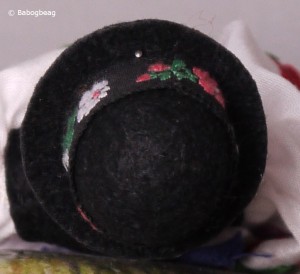General description: The woman is wearing the traditional costume of a Matyó Daughter of Mary, while the man is wearing the typical festive attire of a Matyó man. The Matyó embroidery on the man’s costume is part of the Unesco designated intangible cultural heritage.
Dimensions Man: 19 x 12 x 6 cm; woman: 19 x 12 x 8 cm
Date when acquired 2015
Original Date 1978
Source Bought over EBay by Gisela H. as a present. The original owners said they had bought the couple in 1978.
The dolls are hand embroidered using original Hungarian folk art motives and were made by the Hungarian Cooperative Foreign Trading Company. The product has a certification of acceptance by the Hungarian Council of Folk Arts and Crafts
Body
The heads of both dolls are made of material drawn over a plastic base. The features are painted on. Their bodies are made of padded material. The woman’s hair is hidden under her headdress at the front but it gathered in a short plait at the back tied with white braid embroidered with red and blue flowers in the same style as her skirt.
Clothing
Woman: The bride is wearing an ensemble in the style worn by the Daughter’s of Mary made of a white brocade blouse with short puffed sleeves with white lace around the cuffs and on blouse’s peplum. The peplum reaches from the waist to the hips and is covered with white lace. The peplum is straight at the front but is highly gathered at the back so it sticks out. The blouse has two types of braid appliqué: the upper braid is white one with scalloped edges and embroidered in light blue; the lower braid is embroidered with red and dark blue flowers and green leaves.
She has a long white brocade skirt that is highly pleated apart from the area under the apron (typical of Matyó skirts). Just above the hem is an inset made of medium blue silk braid. Another piece of braid is sewn onto the skirt at the level just below her buttocks. This is again embroidered with red and dark blue flowers and leaves though the design is slightly different form that of the bodice. Under her skirt is a midi-length plain white cotton petticoat and a pair of cotton underpants. Over the front of the skirt is a highly pleated apron made of white brocade (but with a different pattern woven into it than on the skirt) with light blue ribbon sewn just above the edges, which have lace around them. Her black shoes have a piece of leather at the front forming a point going up the front of the leg.
On her head is a floral headdress (blue, pink and white flowers) with a veil made of white netting hanging down to the level of her hips. Silver tinsel-like ribbons are attached to the headdress. There are also two silver pointed “rods” attached to the headdress on the left.
Man: The bridegroom is wearing a very long- and wide-sleeved shirt. The front of the shirt and around the arms of the sleeves is typical Matyó floral embroidery in red, blue, green, pink and orange. Around the neck as a form of high collar is a piece of white braid embroidered with red.
Over the shirt, he is wearing a black felt waistcoat that is open at the front and is embroidered with yellow wool to form three oblongs on each side of the chest. On the lower part of his body are highly pleated gatya (culotte-style trousers) with white fringing along the bottom of the legs. Over these he is wearing the typical Matyó black fringed apron, embroidered with a floral and cross stitch design in red, yellow, brown, pink and white. He is wearing a pair of black boots with the typical curved top.
He has the typical Matyó high-crowned “Bowler” hat on his head with a piece of black braid around the crown embroidered with a floral design in white, pink and green. It is missing the feathers and ribbons that usually trim this type of hat.
Accessories
None
Background information
The Daughters of Mary is a Catholic sodality (religious guild) devoted to Mary, the Mother of Jesus Christ.
Quite how a hat designed by hatmakers in London (UK) in 1849 came to be adopted by men from the Matyó, a Hungarian ethnographic group, I do not know. The name Bowler hat comes from the surname of one of the two London hat-makers Thomas and William Bowler, though it is also called a billycock, bob hat or derby. The Bowler hat was adopted by men from various classes in Britain, Ireland and the USA. In fact, the bowler, was the most popular hat in the American West, not the cowboy hat or sombrero as seen in cowboy films. Quechua and Aymara women have worn this style of hat since the 1920s, when it was introduced to Bolivia by British railway workers (it is called bombín in Spanish). A little closer to Hungary is Austria, and the Bowler hat (Stresser) is a mandatory part of the official uniform of Viennese horse cab drivers.
See Hungary: Matyó, Upper Hungary – general information
(1.9.3 & 1.9.4)





